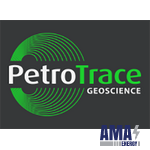Structural and Dynamic Interpretation
Geological support
Careful collection, loading and analysis of the maximum amount of geological and geophysical information allows our specialists to create a reliable geological basis for the project. The PetroTrace team maximally saturates the seismic interpretation with a geological meaning that is understandable to everyone who further uses the results of our research: from reserves calculation to field development . Interactive software tools for analysis and interpretation of well logging data, validation of cuts and construction of sections for wells increase the productivity of geological support of work.
Horizon and disturbance correlation
The most important stage of interpretation is the combination of seismic and borehole data, as well as the correlation of reflecting horizons and the identification of tectonic disturbances. To optimize the structural interpretation, PetroTrace specialists calculate all the necessary seismic attributes and use volumetric data visualization to quickly understand the geological structure of the work area. Effective manual and automatic tools for correlation and editing of horizons and disturbances in 3D significantly accelerate the process of structural interpretation.
Time-to-depth conversion
The accuracy of structural constructions largely depends on the method of converting data from the temporal to the deep domain and determines the effectiveness of subsequent drilling. PetroTrace interpreters use all available speed information in the area of work and choose the best time-depth recalculation technique depending on the quantity, quality and regularity of the distribution of the source data. Close cooperation between the processing and interpretation groups allows us to effectively use the processing speeds of seismic data to increase the accuracy of depth transformations.
Petrophysical justification
The basis for predicting reservoir properties from seismic data is the boundary parameters, as well as the dependencies established as a result of the analysis of core and well log data. During the petrophysical justification, PetroTrace specialists use all available information according to drilling data. The use of effective analysis and modeling tools allows us to find the relationship between the acoustic parameters of the medium and reservoir parameters and justify the feasibility of predicting properties in the interwell space. The boundary parameters and regression equations established in the process of petrophysical justification are used in interpreting the results of AVO analysis and inversion transformations.
AVO analysis and inversion
The change in the behavior of the wave field is caused by a number of geological and technological factors, such as the lateral change in lithology and fluid type, features of observing systems, anomalies of high-frequency resonance, processing quality, etc. PetroTrace experts analyze the processed seismograms and determine the ranges of partial angular sums to justify and select the most correct way to solve the inverse problem, depending on the totality of features inherent in a particular area of work. We use a wide range of inversion transformation algorithms to obtain data arrays that can be used both for predicting reservoir properties in the interwell space and for refining the structural interpretation.
Attribute analysis
The results of attribute analysis reduce the risks of forecasting reservoir parameters and give a more complete picture of the geological structure of the studied interval. The use of a single seismic attribute cannot characterize the reservoir with a sufficient degree of confidence. To increase the reliability of forecasting the properties of PetroTrace geophysics, technologies of automatic multi-attribute classification, RGB blending and neural networks are used, which allows you to get maps and parameter cubes based on a set of informative seismic attributes.
Forecast AVPD
Information on the depths and lateral distribution of the areas of development of abnormally high pore pressures can significantly reduce the risks, timing and cost of drilling. The PetroTrace team has all the necessary tools and experience in predicting AVPD due to the integration of information on well data and high-resolution arrays of interval velocities obtained during the seismic processing stage. As a result of the project, geologists and drillers have at their disposal a predicted pressure cube, on the basis of which it is possible to build pressure profiles for the trajectories of any planned wells and a pressure map for all target intervals.
Localization of gas pipes (Chimney)
The presence and nature of the arrangement of gas pipes can serve as an additional criterion when deciding on the permeability of faults, the quality of the tire and the migration paths of hydrocarbons. Attribute analysis of the results of processing with preservation of amplitudes and volumetric interpretation of the data allow PetroTrace specialists to efficiently isolate gas pipes that have a response in a seismic field. The results of localization of gas pipes can be used by oil companies to reduce risks in assessing the prospects of oil and gas deposits.
Fracture prediction
Fracturing plays an important role for most carbonate and unconventional reservoirs. PetroTrace geophysicists predict zones of increased fracture due to a combination of geometrical attributes, anisotropy parameters and the dispersed component of the seismic field based on the analysis of fully azimuthal migrated deep seismograms. Fracturing information extracted from seismic data is used in the construction of geological and hydrodynamic models to make effective decisions on plans for the development of oil and gas fields.

